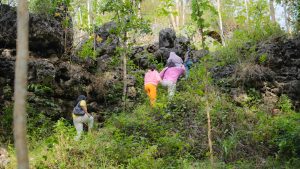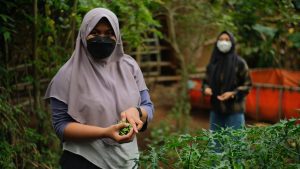Tuesday (12/10), the sun at 02.00 p.m was not able to sting us inside Pawon Pagesangan. Proven by how we were able to enjoy thiwul rice while talking and occasionally throwing jokes.
The circular building with walls made out of bamboo was part of Linda Nu’a’s visit to the Pagesangan School in the hamlet of Wintaos, Girimulyo, Panggang, Gunung Kidul. This activity is called the Mama Fun Residency, Linda’s nickname, and is part of the Biennale Jogja XVI Equator #6 2021 program. She represents the local art, literacy, and food community from Mollo. Lakoat.Kujawas is its name.
“They have this too at Mollo,” said Mama Fun, pointing at the thiwul she was eating. Lined with banana leaves, the thiwul rice is sweet instead of salty. Mama Fun said, in Mollo, processed cassava is eaten as a main dish with side dishes accompanied by sambal lu’at.
“That’s how it usually is,” said Murniyatun as a representative of the Pagesangan School.
Murni’s words were welcomed by one of the participants. Freddy, Mama Fun’s companion, told a story about thiwul which is usually eaten with chili sauce, vegetables, and tempe garit. Similar to in Mollo.
“Yeah! That’s right, it tastes great!” exclaimed Titis, a participant from the Biennale Jogja XVI team, which was then greeted by a nod from the Pagesangan School activists who were also present in Pawon.
It didn’t just stop at thiwul, the similarities between Mollo and Wintaos emerged one by one through casual chats. It was so relaxed, the Power Point presentation, which had been set to Pure, was simply put on hold. Everyone is involved in an exchange of ideas.
One of them was the community vision. Murni emphasized that the Pagesangan School exists to empower Wintaos village residents. So is Mama Fun.
 Similarities are also found in environmental landscapes. “Mollo’s neighborhood is more or less like Wintaos. Rocky but still green,” she explained.
Similarities are also found in environmental landscapes. “Mollo’s neighborhood is more or less like Wintaos. Rocky but still green,” she explained.
She said that the greenery in these two villages was not made magically overnight but through the efforts of the residents who plant and nurture corps and plants.
After discussing similarities in the price of PDAM water, which cost Rp. 450,000/tank, the conversation turns into serious matters. While chewing cassava crackers with its crunchy sound, Titis asked, “What are Mama Fun and Murni’s toughest challenges in building communities and empowering villages?”
Both of them mentioned the slanted and belittling opinions of other residents. They’re accused to be wasting time and making things more difficult than necessary. But to them, those opinions are not surprising and they’re not too bothered by their existence. “The depleting human resources into urban areas is the most serious problem,” both answered, concerned.
In fact, it was this case of the fast pace of urbanization that became the trigger for the establishment of these two village empowerment communities. Mama Fun has a variety of interesting stories from her area about urbanization. Starting from women who moved from the village to get straight hair in the city to a friend who acts like their stomach can no longer able to process corn. “Nonsense. Because I have known since childhood that the child eats corn in Mollo,” She said.
Likewise, in Wintaos similar events happened. Murni admits that only a handful of villagers are willing to live in the village. “Of the 40 members of the second batch of Pagesangan School, I am the only one who serves as a cadre here,” she said.
Young people, she lamented, were tempted by the lure of Jogja instead of living in Wintaos.
Both Mama Fun and the Wintaos ladies agreed that all the city has to offer is prestige. “It’s about lifestyle. They think the city life can make us look good in the eyes of other people,” said Mama Fun.
When asked if migrating will guarantee prosperity than living in their ancestral land, almost all of the participants shook their heads in unison.
Even Mama Fun has a sad story about this urban temptation. “Many Mollo residents are tempted by the offer of TKI or blue-collared workers abroad. What went wasn’t prestige, but a coffin,” she said.
 To lessen the temptation of city life, Murni and her friends from the Pagesangan School made a strategy. “If they go to the city looking for prosperity, we need to show that the village can also provide it,” she said.
To lessen the temptation of city life, Murni and her friends from the Pagesangan School made a strategy. “If they go to the city looking for prosperity, we need to show that the village can also provide it,” she said.
For example, various processed agricultural products are sold by the Pagesangan School online under the label Kedai Sehat Pagesangan.
Likewise in Lakoat.Kujawas. She told me about her friend who pretended to be a bourgeoisie before, who refused to eat corn because they think it’s for country bumpkins.
“She showed off a pizza she bought from town. We can prove that Mollo can have that too without needing to go elsewhere,” she said.
Lakoat.Kujawas then experimented with making pizza using local ingredients, from yeast to toppings.
In the end, the sneers turned into curiosity.
“My friends, even those outside Wintaos, started asking questions about our recipe,” Murni confessed.
Mama Fun was also flooded with questions about forest vegetable processing techniques.
“Previously, they said that planting crops is a waste because everything can be bought. Now, they are curious,” she said with a satisfied laugh.
That’s how Mollo and Wintaos ward off the city’s temptations. The chatter continues to fill my mind even when I made my last turn before the gates that lead me out of Wintaos.
At that moment, on the left side of the road, I saw a barbershop there. In addition to welfare, the villagers also can and need to keep up with fashion.